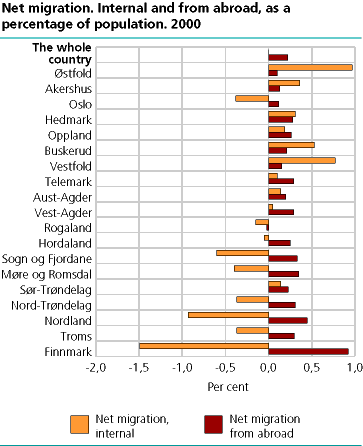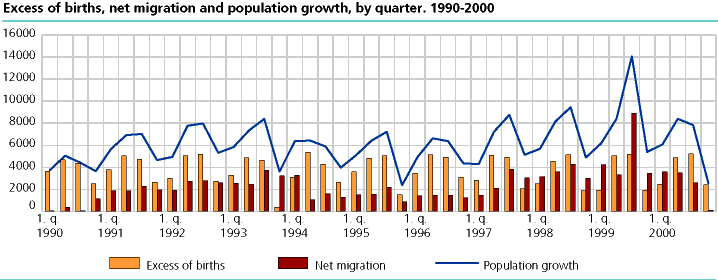Content
Published:
This is an archived release.
Excess of births drives up population
In contrast to the year before, it was an excess of births over deaths, not immigration, that had the biggest impact on population growth in 2000. Preliminary figures show that the excess of births over deaths for 2000 was 15 000, while the immigration surplus fell from 19 000 to 10 000.
The excess of births over deaths increased by 1 000 compared with 1998 and 1999, and is about the average for the 1990s. While the number of births is fairly stable at 59 200, the number of deaths fell to 44 200.
Preliminary figures show that Norways population has increased by 25 000, with the excess of births over deaths accounting for 60 per cent of this. Most counties had an excess of births over deaths in 2000. Akershus, Oslo, Rogaland and Hordaland all had well over 2 000 more births than deaths. Three counties had a deficit: Hedmark, Oppland and Telemark had fewer births than deaths in 2000, as well as in most years in the 1990s. The stability of the pattern is linked to low fertility and the relatively high number of elderly persons living in these counties.
Immigration surplus cut in half
While immigration caused large population growth in 1999, in fact the largest ever registered, immigration from abroad was almost cut in half in 2000. Net migration fell by almost 9 000, to 10 000 in 2000. Net migration from abroad has varied considerably in the 1990s, from 1 800 in 1990 to 19 300 in 1999, with an annual average of nearly 10 000. What was special about 1999 was the high number of Kosovo Albanian refugees.
Iraqis and Russians are coming...
In 2000, 36 500 persons immigrated into Norway, while 26 600 emigrated. Immigration was 5 200 lower than in 1999, while emigration was up 4 300. Iraqi citizens accounted for the largest net immigration in 2000, with just over 4 400. For Somalis the corresponding number was 1 400.
From Europe, Russian citizens accounted for the largest net immigration in 2000, with Russian immigration outstripping emigration by 750. In 1999 and 1998 the numbers were 680 and 500, in 1997 420. Seen in relation to the Russian population in Norway at 1 January 2000, 2 750 persons, the numbers are high.
Afghanistan also set itself apart compared to earlier years, with a migration surplus of 500 Afghani citizens. In 1999 there were no more than 200, in 1998 40.
... while the Swedes are leaving
Of Norways Nordic neighbours, most of the migration to Norway was by Swedes, followed by Danes. Last year the migration balance with Sweden nevertheless went into the minus column: after several years of significant influxes of Swedish citizens the flow reversed to a small migration loss in 2000. The change may be related to Swedens economic boom and attendant demand for labour.
Net migration of Norwegian citizens showed a deficit: while 8 700 Norwegian citizens moved back to Norway, the lowest number since 1989, 11 800 Norwegian citizens left the country, the highest since 1990. An emigration surplus of 3 000 persons is high, and in the last four decades only the number for 1988-1990 is higher.
Oslo loses, Østfold wins
Nordland had a domestic migration loss of 2 200 persons in 2000, the highest of all counties. Oslo had the second highest migration loss to other counties, with 1 900, followed by Finnmark, with 1 100. All counties in Eastern Norway, save Oslo, and the Agder counties saw net migration from the rest of the country. Except for Sør-Trøndelag, all coastal counties from Rogaland northwards had losses.
For the fourth year in a row, Oslo experienced a net migration loss vis-à-vis other counties. The migration loss was reduced from 1 800 in 1998 to 700 in 1999, but increased again to 1 900 in 2000. While for several years Akershus has been drawing the most, Østfold had the largest net migration gain in 2000, with 2 400. Akershus' figure was 1 700.
The three northernmost counties had an overall migration loss to other counties of 3 900. This is an increase of 1 100 from the year before, but is still lower than in 1997 and 1998, with 5 800 and 4 600 respectively.
Finnmark lost the most residents to other counties, seen in relation to the population, while Østfold had the biggest domestic migration gain. At the same time as Finnmark had a deficit in its migration balance for domestic migration, the county received the largest gain from abroad in proportion to its population.
Immigration yields migration gain
All counties apart from Rogaland had a migration gain vis-à-vis other countries. Hordaland and Nordland had a migration gain of nearly 1 100 persons each. For Northern Norways part, the migration gain of 2 200 from abroad compensated for more than half of the domestic migration loss. Oslo and Akershus together had a migration gain including from abroad of 1 200, 3 200 fewer than in 1999.
One-third of the growth to Østfold and Akershus
Østfold and Akershus received nearly a third of the overall population growth in 2000. The rest of the counties along the Oslo fjord also claimed nearly a third of the growth, Hordaland and Rogaland together 20 per cent.
Norways population at 1 January 2001 was 4 503 400.
The statistics is published with Population.
Contact
-
Statistics Norway's Information Centre
E-mail: informasjon@ssb.no
tel.: (+47) 21 09 46 42


